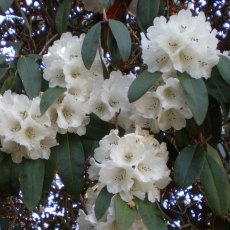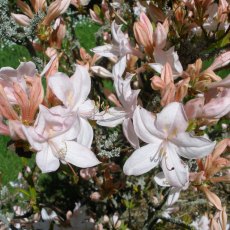Rhododendron cinnabarinum BL&M 234 'Roylei'
Item: SCINNB
 Currently Unavailable
Currently Unavailable
May-June
Red
125-150cm
Not Scented
Yes
To -15 °C
Collect in Store
This item is available for collection.
Home Delivery
UK mainland delivery from £8.95
Wonderful profusion of pendant tubular red to plum crimson flowers in May and June. This plant has superb bluey-grey young foliage. Best in partial shade and it does need an open situation to allow lots of air circulation but also must be protected from frost. Height 120cm in 10 years.
The painting is by Walter Hood Fitch, who re-worked Hooker's original field sketch. It appears in Hooker's landmark book 'Rhododendrons of the Sikkim Himalaya', published in 1849.
This particular plant was collected by Roy Lancaster, (as part of the University of Bangor expedition to NE Nepal), it was a great privelege to show him 'his' plant flowering and thriving in our garden, where he greatly admired it! You will note that the collector seed number appears in the name. This identifies where the plant was collected from, when and by whom. Plant collectors carefully document where they find their seeds and this is of particular interest to Rhododendron enthusiasts. This is a rare plant that will be of particular interest to enthusiasts.
- Recommended for stunning foliage and a wonderful architectual plant.
- Plantsman range.
- Ideal position: needs careful site selection.
- Habit: upright.
- Group: Small Leaved Rhododendron.
- Subsection: Cinnabarina.
- Introduction date: pre 1900 (1849).
- Species distribution: Roylei group distribution: East Nepal, Bhutan, SE Tibet.
- Approximate altitude: 2,100-4,000m
- Ideal soil: pH 4.5 to 6.0
- RHS Hardiness Rating: H5.
- How we usually propagate this plant: Cutting.
Customer Reviews





Size Guide

The Basics
Ideal soil
Acidic soil, good organic content, pH 4.5-6.0. Inkarho range of rhododendrons will tolerate soils up to pH7.5
Sun or Shade
Light dappled shade is best for most varieties.
Shelter
Refer to hardiness rating. Give young plants protection.
Site Selection
Avoid close to trees, roots, invasive weeds, walls, hot patios, dry banks and waterlogged soils. Do not use weed matting or stone mulch.
Plant spacing
Use the height shown in 10 years as a guide to the distance between each plant. Allow room for plant to fill out. If planting closer for instant impact, be prepared to move plants after a few years.
Compost
- 3 litre pot, dig in 10-20 litres of ericaceous compost.
- 7.5 litre pot, dig in 20-30 litres of ericaceous compost.
- 70-80cm specimen, dig in 60 litres of ericaceous compost.
- 100-120cm specimen, dig in 120 litres of ericaceous compost.
Planting depth
Plant high in the ground, with the top of the rootball visible.
Feeding
Slow-release ericaceous feed recommended in March and straight after flowering.
Mulch
Recommended every few years.
Water
The key ingredient! Keep moist all season, especially the critical time at end of June for flower bud initiation. Tap water is better than no water. Heavy dose at least once per week in dry weather.
Drainage
Ensure good drainage in winter, especially with yellow flowering varieties. Avoid waterlogged sites.
Pruning
Rhododendrons and Camellias: Not normally required. Tidy wayward shoots after flowering.
Evergreen azaleas and Bloombux can be clipped into a low hedge.
Magnolias and Acers: Formative pruning when young to shape into a tree or bush.
Deadheading
Remove old flower-heads, particularly on young or weak plants.
For further advice see here
Delivery & Returns
Our website calculates the delivery charge according to weight and delivery location throughout the UK. To see these charges, please enter your postcode at the checkout, and you will see the charge vary as you add more items to your wheelbarrow.
 Millais Nurseries
Millais Nurseries















